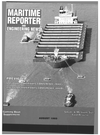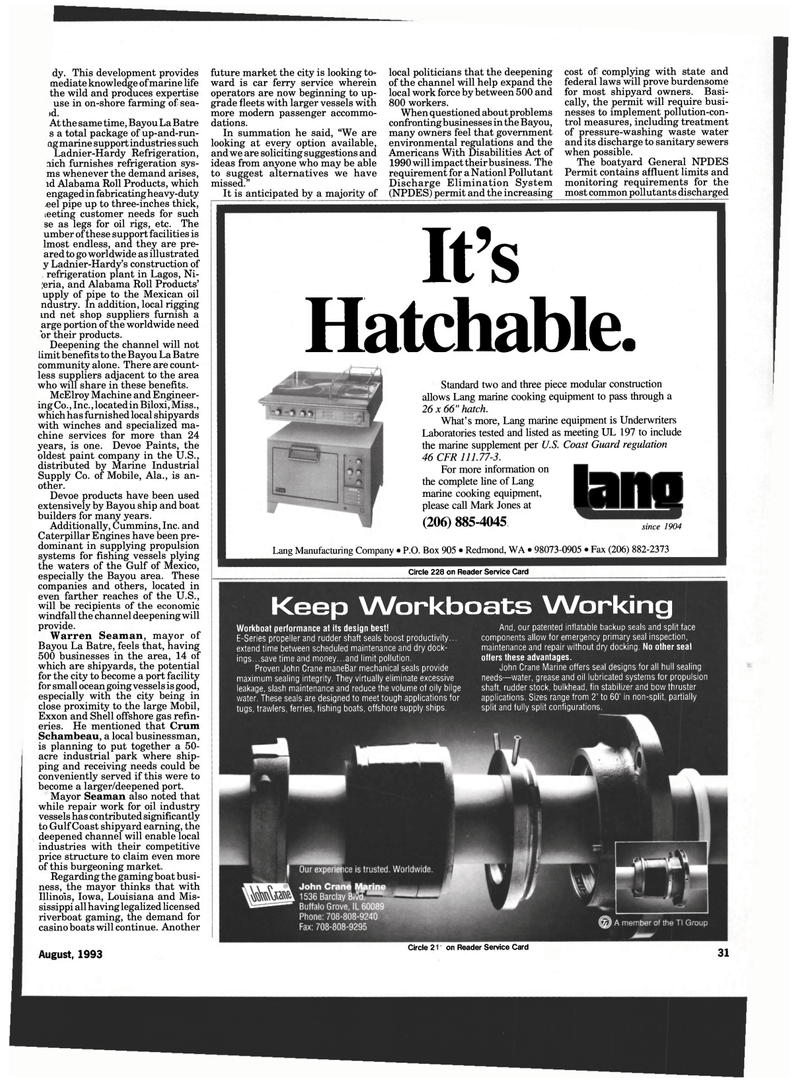
Page 29: of Maritime Reporter Magazine (August 1993)
Read this page in Pdf, Flash or Html5 edition of August 1993 Maritime Reporter Magazine
dy. This development provides mediate knowledge of marine life the wild and produces expertise use in on-shore farming of sea- >d.
At the same time, Bayou La Batre s a total package of up-and-run- cig marine support industries such
Ladnier-Hardy Refrigeration, tiich furnishes refrigeration sys- ms whenever the demand arises, id Alabama Roll Products, which engaged in fabricating heavy-duty .eel pipe up to three-inches thick, ieeting customer needs for such se as legs for oil rigs, etc. The umber ofthese support facilities is lmost endless, and they are pre- ared to go worldwide as illustrated y Ladnier-Hardy's construction of refrigeration plant in Lagos, Ni- ;eria, and Alabama Roll Products' upply of pipe to the Mexican oil ndustry. In addition, local rigging ind net shop suppliers furnish a arge portion of the worldwide need 'or their products.
Deepening the channel will not limit benefits to the Bayou La Batre community alone. There are count- less suppliers adjacent to the area who will share in these benefits.
McElroy Machine and Engineer- ing Co., Inc., located in Biloxi, Miss., which has furnished local shipyards with winches and specialized ma- chine services for more than 24 years, is one. Devoe Paints, the oldest paint company in the U.S., distributed by Marine Industrial
Supply Co. of Mobile, Ala., is an- other.
Devoe products have been used extensively by Bayou ship and boat builders for many years.
Additionally, Cummins, Inc. and
Caterpillar Engines have been pre- dominant in supplying propulsion systems for fishing vessels plying the waters of the Gulf of Mexico, especially the Bayou area. These companies and others, located in even farther reaches of the U.S., will be recipients of the economic windfall the channel deepening will provide.
Warren Seaman, mayor of
Bayou La Batre, feels that, having 500 businesses in the area, 14 of which are shipyards, the potential for the city to become a port facility for small ocean going vessels is good, especially with the city being in close proximity to the large Mobil,
Exxon and Shell offshore gas refin- eries. He mentioned that Crum
Schambeau, a local businessman, is planning to put together a 50- acre industrial park where ship- ping and receiving needs could be conveniently served if this were to become a larger/deepened port.
Mayor Seaman also noted that while repair work for oil industry vessels has contributed significantly to Gulf Coast shipyard earning, the deepened channel will enable local industries with their competitive price structure to claim even more of this burgeoning market.
Regarding the gaming boat busi- ness, the mayor thinks that with
Illinois, Iowa, Louisiana and Mis- sissippi all having legalized licensed riverboat gaming, the demand for casino boats will continue. Another
August, 1993 future market the city is looking to- ward is car ferry service wherein operators are now beginning to up- grade fleets with larger vessels with more modern passenger accommo- dations.
In summation he said, "We are looking at every option available, and we are soliciting suggestions and ideas from anyone who may be able to suggest alternatives we have missed."
It is anticipated by a majority of local politicians that the deepening of the channel will help expand the local work force by between 500 and 800 workers.
When questioned about problems confronting businesses in the Bayou, many owners feel that government environmental regulations and the
Americans With Disabilities Act of 1990 will impact their business. The requirement for a Nationl Pollutant
Discharge Elimination System (NPDES) permit and the increasing cost of complying with state and federal laws will prove burdensome for most shipyard owners. Basi- cally, the permit will require busi- nesses to implement pollution-con- trol measures, including treatment of pressure-washing waste water and its discharge to sanitary sewers when possible.
The boatyard General NPDES
Permit contains affluent limits and monitoring requirements for the most common pollutants discharged
It's Hatchable.
Standard two and three piece modular construction allows Lang marine cooking equipment to pass through a 26 x 66" hatch.
What's more, Lang marine equipment is Underwriters
Laboratories tested and listed as meeting UL 197 to include the marine supplement per U.S. Coast Guard regulation 46 CFR 111.77-3.
For more information on the complete line of Lang marine cooking equipment, please call Mark Jones at (206) 885-4045 lane since 1904
Lang Manufacturing Company • P.O. Box 905 • Redmond, WA • 98073-0905 • Fax (206) 882-2373
Circle 228 on Reader Service Card
Keep Workboats Working
Workboat performance at its design best!
E-Series propeller and rudder shaft seals boost productivity... extend time between scheduled maintenance and dry dock- ings.. .save time and money.. .and limit pollution.
Proven John Crane maneBar mechanical seals provide maximum sealing integrity. They virtually eliminate excessive leakage, slash maintenance and reduce the volume of oily bilge water. These seals are designed to meet tough applications for tugs, trawlers, ferries, fishing boats, offshore supply ships.
And, our patented inflatable backup seals and split face components allow for emergency primary seal inspection, maintenance and repair without dry docking. No other seal offers these advantages.
John Crane Marine offers seal designs for all hull sealing needs—water, grease and oil lubricated systems for propulsion shaft, rudder stock, bulkhead, fin stabilizer and bow thruster applications. Sizes range from 2" to 60" in non-split, partially split and fully split configurations.
Circle 287 on Reader Service Card 31

 28
28

 30
30
